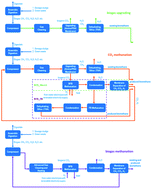当前位置:
X-MOL 学术
›
Sustain. Energy Fuels
›
论文详情
Our official English website, www.x-mol.net, welcomes your
feedback! (Note: you will need to create a separate account there.)
Life cycle assessment of power-to-gas with biogas as the carbon source
Sustainable Energy & Fuels ( IF 5.0 ) Pub Date : 2019/12/17 , DOI: 10.1039/c9se00986h Xiaojin Zhang 1, 2, 3 , Julia Witte 2, 3, 4 , Tilman Schildhauer 2, 3, 4 , Christian Bauer 1, 2, 3
Sustainable Energy & Fuels ( IF 5.0 ) Pub Date : 2019/12/17 , DOI: 10.1039/c9se00986h Xiaojin Zhang 1, 2, 3 , Julia Witte 2, 3, 4 , Tilman Schildhauer 2, 3, 4 , Christian Bauer 1, 2, 3
Affiliation

|
Electricity generation from renewable sources is increasing and will grow further in the future. Since some of this renewable electricity is intermittent and cannot always be consumed when it is generated, options for matching energy demand and supply are needed. Besides electricity storage, coupling the electricity and gas sectors by converting renewable electricity to hydrogen through water electrolysis can be considered a promising option. With CO2 obtained from various sources, hydrogen can further be reacted to produce methane to facilitate large scale gas storage. Among “Power-to-methane” systems, there are a few pathways designed to utilize the CO2 from biogas. However, studies that quantify life cycle greenhouse gas (GHG) emissions of such systems are limited, yet are an essential basis when comparing such systems with other alternatives regarding decarbonisation of the energy system. This study therefore focuses on addressing this research gap by providing transparent life cycle inventories and analyses and investigating the life cycle GHG emissions of biogas upgrading, methanation with CO2 from biogas upgrading, and direct biogas methanation. These systems are compared with other fuels in the mobility sector. The analysis also provides an estimate of the potential of such systems to reduce GHG emissions on a country level by considering the availability of biomass and the required amount of renewable electricity. In addition, the results are compared with those of power-to-methane pathways using other CO2 sources and literature values. Our analysis shows that using biomethane as vehicle fuel produced by the systems investigated could provide GHG emission reductions of 27–62% compared to conventional natural gas passenger vehicles or 41–70% compared to petrol vehicles. Although the limited resources of suitable biomass will be a constraint to the widespread deployment of power-to-methane systems using biogenic carbon, the available potential should be used, since it represents an attractive option for reduction of GHG emissions in a future energy system with large amounts of intermittent renewable power generation.
中文翻译:

以沼气为碳源的沼气发电生命周期评估
来自可再生能源的发电量正在增加,并将在未来进一步增长。由于这种可再生电力中的一些是间歇性的,并且在产生时不能总是被消耗掉,因此需要用于匹配能源需求和供应的选择。除了蓄电之外,通过水电解将可再生电力转化为氢气,将电力和天然气部门耦合起来也被认为是一个有前途的选择。利用从各种来源获得的CO 2,氢可以进一步反应生成甲烷,以促进大规模的气体存储。在“沼气发电”系统中,有一些利用CO 2的途径来自沼气。但是,量化此类系统生命周期温室气体(GHG)排放的研究是有限的,但在将此类系统与有关能源系统脱碳的其他替代方案进行比较时,却是必不可少的基础。因此,本研究着重于通过提供透明的生命周期清单和分析并调查生命周期中沼气升级,CO 2甲烷化的温室气体排放来解决这一研究空白。沼气升级和直接沼气甲烷化。这些系统与出行领域的其他燃料进行了比较。分析还通过考虑生物量的可获得性和所需的可再生电力量,对此类系统在国家一级减少温室气体排放的潜力进行了估算。此外,将结果与使用其他CO 2的甲烷转化为动力的结果进行了比较资料和文献价值。我们的分析表明,使用生物甲烷作为所研究系统生产的车辆燃料,与传统的天然气乘用车相比,可减少27-62%的温室气体排放,与汽油车相比,可减少41-70%的温室气体排放。尽管有限的合适生物质资源将限制使用生物碳的沼气发电系统的广泛部署,但应利用可利用的潜力,因为这是减少未来能源系统中GHG排放的有吸引力的选择。大量间歇性可再生能源发电。
更新日期:2020-03-03
中文翻译:

以沼气为碳源的沼气发电生命周期评估
来自可再生能源的发电量正在增加,并将在未来进一步增长。由于这种可再生电力中的一些是间歇性的,并且在产生时不能总是被消耗掉,因此需要用于匹配能源需求和供应的选择。除了蓄电之外,通过水电解将可再生电力转化为氢气,将电力和天然气部门耦合起来也被认为是一个有前途的选择。利用从各种来源获得的CO 2,氢可以进一步反应生成甲烷,以促进大规模的气体存储。在“沼气发电”系统中,有一些利用CO 2的途径来自沼气。但是,量化此类系统生命周期温室气体(GHG)排放的研究是有限的,但在将此类系统与有关能源系统脱碳的其他替代方案进行比较时,却是必不可少的基础。因此,本研究着重于通过提供透明的生命周期清单和分析并调查生命周期中沼气升级,CO 2甲烷化的温室气体排放来解决这一研究空白。沼气升级和直接沼气甲烷化。这些系统与出行领域的其他燃料进行了比较。分析还通过考虑生物量的可获得性和所需的可再生电力量,对此类系统在国家一级减少温室气体排放的潜力进行了估算。此外,将结果与使用其他CO 2的甲烷转化为动力的结果进行了比较资料和文献价值。我们的分析表明,使用生物甲烷作为所研究系统生产的车辆燃料,与传统的天然气乘用车相比,可减少27-62%的温室气体排放,与汽油车相比,可减少41-70%的温室气体排放。尽管有限的合适生物质资源将限制使用生物碳的沼气发电系统的广泛部署,但应利用可利用的潜力,因为这是减少未来能源系统中GHG排放的有吸引力的选择。大量间歇性可再生能源发电。











































 京公网安备 11010802027423号
京公网安备 11010802027423号